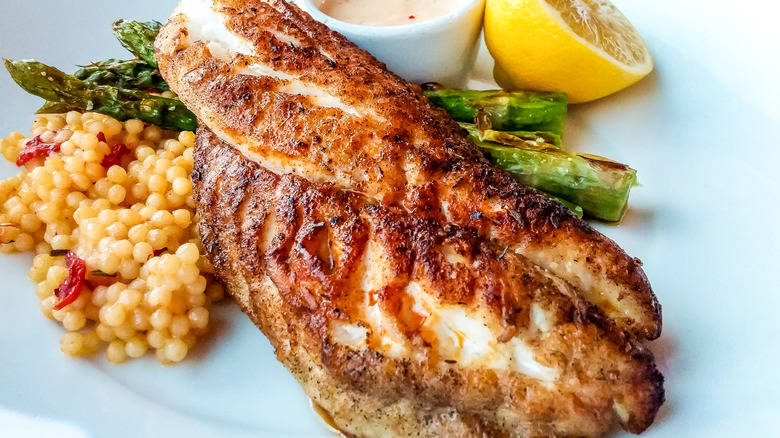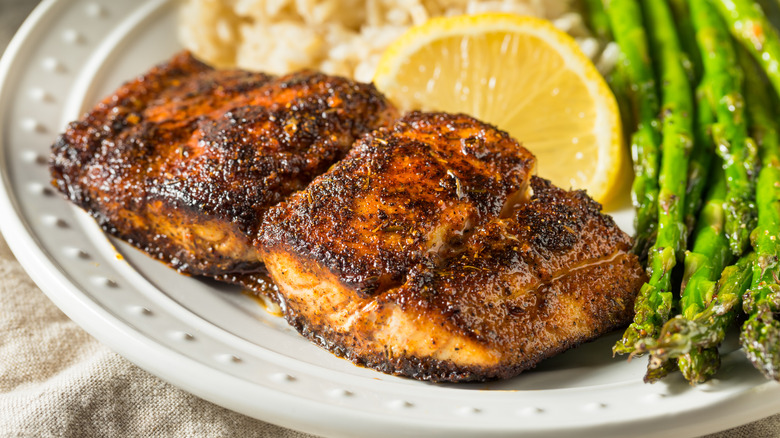Why The Introduction Of Blackened Redfish Caused A Fishing Ban
Trendy dishes often cause a wave of attention and sometimes even mania (cronuts, anyone?), but only one comes to mind for needing to involve the Federal government: chef Paul Prudhomme's blackened redfish. Redfish, also known as red drum, are found in the Gulf of Mexico and the Atlantic Ocean. They have a firm yet tender texture and a mild flavor, making them perfect for coating in vibrant spices. Prudhomme dipped the fish fillets in butter and dredged them in a flavor medley including cayenne, paprika, thyme, and oregano. He then seared the fillets in a scorching hot pan, creating a charred, blackened crust.
Prudhomme introduced the dish at his New Orleans restaurant in 1981. It quickly caught on, and from coast to coast, the country went crazy for blackened redfish. Lines formed outside Prudhomme's restaurant, and Cajun cuisine made a name for itself outside of the South. Prudhomme was soon catapulted to worldwide fame, and the dish became synonymous with New Orleans.
The dish was meant for redfish native to the Louisiana coast, but due to its immense popularity, commercial fishermen caught any redfish they could find. Overfishing began to take a toll on the population, with 12.7 million pounds harvested in just one year in the Gulf alone (per Alabama Cooperative Extension System). The government acted quickly, and a full-on ban on commercial fishing of redfish was fully in effect by 1987. Worry over the depletion of the species also led to quantity and size restrictions for recreational fishing.
How the ban affected the fish and the dish
The ban worked. Redfish just about disappeared from restaurant menus and store seafood sections. Upset by the consequences of the craze and feeling a bit responsible, Paul Prudhomme considered taking the dish off his menu at his New Orleans restaurant, K-Paul's, in hopes of quelling the fervor. He ended up enacting a limit of one order of the dish per table.
The species is still protected to this day. Regulations on the fishing of redfish are set state by state and vary. Most of the Southern states only permit recreational fishing, and have strict limits on the amounts and size of the fish allowed to be caught. South Carolina through Florida coasts have a ban on commercial harvesting and selling. In the Gulf of Mexico, Florida, Alabama, Louisiana, and Texas also ban commercial fishing of redfish — Mississippi is the only state that allows it.
Instead of disappearing due to the ban, the dish itself just adapted to the restrictions. The blackened method began to extend beyond just redfish. It wasn't long before chicken, shrimp, fish tacos, pork chops, vegetables, and just about anything was blackened and gracing the pages of restaurant menus. You may be wondering what you are getting when and if you come across redfish today. If you see it in a store or on a menu, it's most likely farm-raised and from Texas, though redfish is also farmed globally.
History of the dish and how to recreate it
While Paul Prudhomme is credited for creating blackened redfish, he merely adapted an existing cooking method in New Orleans to redfish and brought it mainstream. Because he didn't have a wood-burning grill in his small restaurant, Prudhomme turned to spices and a sizzling cast iron pan to emulate a charred grill flavor and effect. The result was his infamous dish.
If the redfish rules have you down, the good news is, blackening makes just about anything taste delicious. But if you wish to honor the redfish, there are other species that aren't protected and fit the bill for the dish. The fish is pan-seared over high heat for a spicy crust, so any firmer fish, such as red snapper, mahi-mahi, and grouper, work well. A Cajun blackened catfish will also hold up nicely to the sear and spice. Charring food isn't the same as blackening it, so a grill is not, and never was, required.
It's hard to exactly emulate the classic dish at home — a white-hot pan like Prudhomme's may have you smoking out your kitchen. However, you can get pretty close with seasoning and a pan-sear. Prudhomme launched a product line that has become a spice aisle mainstay, making it easy to use the larger-than-life chef's exact blackening blend. And if fish isn't your thing, you may already be recreating a Prudhomme classic: He also popularized one of the hardest dishes to make from scratch — the turducken.



